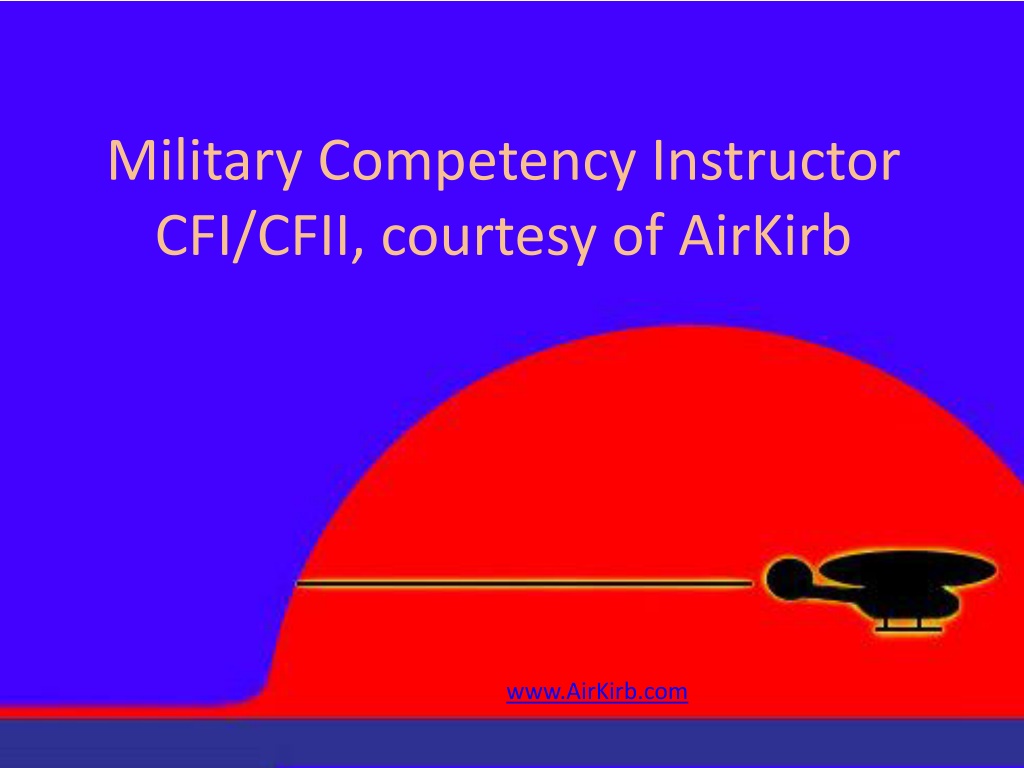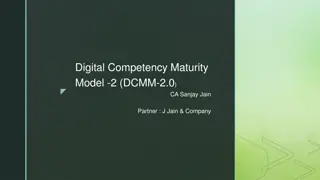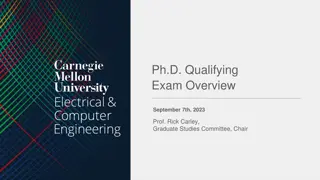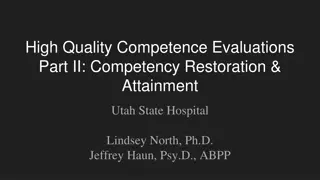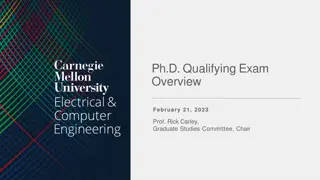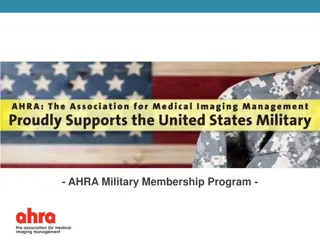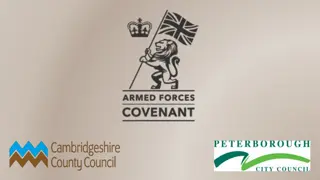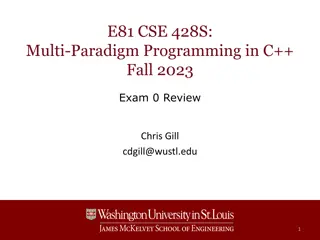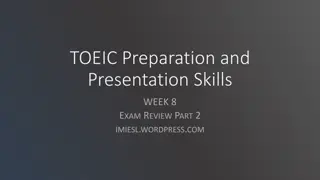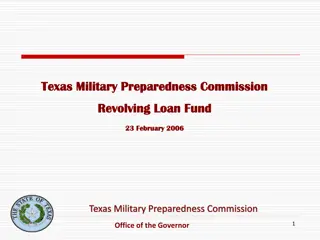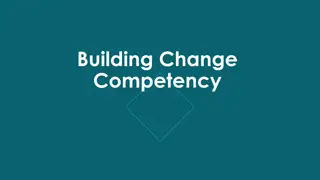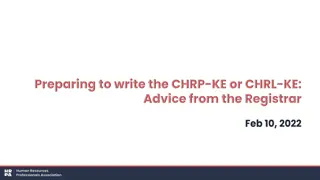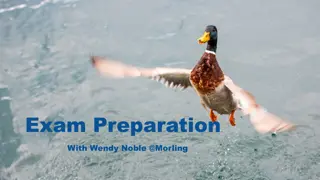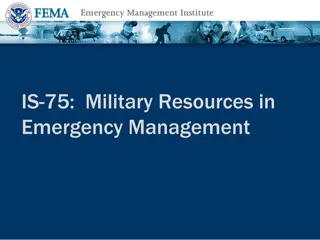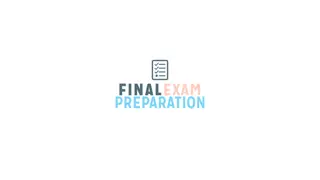Military Competency Exam Preparation Tips
Get ready for the Military Competency Instructor (CFI/CFII/MEI) exam with valuable insights on FAA regulations, study resources, and testing centers. Prepare efficiently for a successful outcome in your aviation certification journey.
Download Presentation

Please find below an Image/Link to download the presentation.
The content on the website is provided AS IS for your information and personal use only. It may not be sold, licensed, or shared on other websites without obtaining consent from the author.If you encounter any issues during the download, it is possible that the publisher has removed the file from their server.
You are allowed to download the files provided on this website for personal or commercial use, subject to the condition that they are used lawfully. All files are the property of their respective owners.
The content on the website is provided AS IS for your information and personal use only. It may not be sold, licensed, or shared on other websites without obtaining consent from the author.
E N D
Presentation Transcript
Military Competency Instructor CFI/CFII, courtesy of AirKirb www.AirKirb.com
What you are here for To take (and pass) the military competency exam for Certified Flight Instructor To have your paperwork checked before you go to your regional FAA Flight Standards District Office (FSDO) To gather insights on where to go from here, in order to get you up and instructing
Chris Kirby CDR, USN (18 years) HH-46D, MH-60S, TH- 57B/C (instructor) (B206), R-22, S-300C Commercial Instrument Multi-Engine Airplane and Rotary, CFII Rotary With Civic Helicopters for over a year
Tips for preparing for the Military Competency Instructor (CFI/CFII/MEI) exam: Get familiar with the 14 CFR (formally FAR) Part 61, Certification: Pilots, Flight Instructors, and Ground Instructors. Know the requirements for private, commercial, CFI and ATP for all aircraft (MCI written doesn t discriminate, even though you will obtain CFI/CFII for the category aircraft you are qualified in) (we ll go over some of these in class today)
Tips for preparing for the Military Competency Instructor (CFI/CFII/MEI) exam (cont d): Read FAA H-8083-9A, the Aviation Instructor s Handbook (PDF available free online, or enclosed with your Welcome to AirKirb e- mail). This does not have a lot about flying in it, but it does contain basic instruction techniques and a lot about the process of learning. A good percentage of the questions on the exam are from this book.
Tips for preparing for the Military Competency Instructor (CFI/CFII/MEI) exam (cont d): I highly recommend Sheppard Air s Military Competency Instructor Test Prep Software (http://www.sheppardair.com/mcs.htm). There are other companies (American Flyers, for example), and I invite you to research them, but I used Sheppard Air, and I know many others who have and have not heard of a failure to date. You will be familiar with the types of questions on the exam after taking the time to review all of the test prep software. If you are unable to get access to the internet, ASA produces the Certified Flight Instructor Test Prep, which is available at most aviation stores (and online, that is, if you have access). The text does have provisions for the Military Competency Exam.
The rubber meets the road When it is time to take the exam, find a testing center by going to http://www.faa.gov/training_testing/testing/ media/test_centers.pdf and find a testing center in your area. There is a fee (typically around $150.00). (There is one here at Civic!) 125 Questions, you are allotted 3 hours to complete.
Success!! After you pass the exam: You will need to find a FAA Flight District Standards Office (FSDO) in your area by going to: http://www.faa.gov/about/office_org/field_of fices/fsdo/.
Now the tricky part Once you have an appointment, you will need the following items for the FAA inspector: Your NATOPS jacket, or military flight record. The FAA 8710-1 application form (completed, as this will speed things up). The original print out from the MCI test, showing your passing score. All log books, complete with endorsements (military and civilian log books).
More for the FAA. Any and all documentation that has the word instructor on it. This is the tricky part - I ll do my best to tell you what to expect with the inspector. Depending on your certification, you might get CFII, or just CFI. This includes: 1. A certificate showing the completion of an instructor ground school 2. A certificate or designation as a flight instructor by your command 3. Something showing you passed a proficiency check in the type of aircraft You might not need all three, as the type of designation may be all-inclusive in the eyes of the inspector. There is no sure way to know.
Oh, theres more! A current medical certificate. It has to be at least a Class III medical (military flight physicals satisfy this requirement per 14 CFR part 67). Your FAA Commercial Pilot s License (not a copy). If you don t have one, then we need to talk about military competency for commercial pilot first. I can help with that as well. Two forms of photo ID (driver s license and military ID).
Final Note on the FSDO Every FSDO is different try contacting them to see EXACTLY what they want before you walk in the door. It is best to be prepared
Lets go over a few things. 14 CFR Part 61: Requirements and responsibilities of a CFI/CFII, to include endorsements 14 CFR Part 91: some things you might not be used to as a military pilot FAR 14 CFR PART 91 Fundamentals of instructing. (If you have not served as an instructor at the VT s or HT s, this will be new to you!)
Misc. Definitions Crewmember person assigned to duty in the aircraft during flight Operational control initiating, conducting, or terminating a flight Stopway decelerate an aborted takeoff V2 Takeoff safety speed, ensures that an airplane can maintain an acceptable climb gradient with the critical engine inoperative
Required Documents A-R-R-O-W A Airworthiness Certificate R Registration certificate R Radio Operator s License (not required US) O Operations Specification W - Weight and balance Approved Airplane and Rotorcraft flight manual if required by 14 CFR 21.5 Every pilot must have pilot s license (or student certificate), medical certificate, and a photo ID
Required Documents Certificate Holder s manual that includes enroute flight, navigation and communication procedures for the dispatch, release and continuance of flight in any item of equipment becomes inoperative or unserviceable (given the equipment is necessary for the route of flight) Cockpit voice recorder on from the start of the use of the checklist (before starting engines) to completion of the checklist at the termination of the flight. Information recorded more than 30 minutes earlier may be erased or destroyed.
Medical Certificates Type Under Age 40 Age 40 and Over First Class 12 Months 6 Months Second Class 12 Months 12 Months Third Class 60 Months 24 Months When a certificate of a higher class expires, it reverts to the lower class for the remaining duration (depending on age). For example, an expired First Class (over 40) reverts to an Second Class for the remaining 6 months, then to a Third Class for the 12 months that remain after that. Each type certificate is valid until the last day of the month it was issued.
Student Pilot Certification Student Pilot Certificate expires at the end of the 24th month in which it was issued for pilots 40 and over; at the end of the 60th month it was issued for pilots under 40. Go see the Doctor!
Solo Endorsements Good for 90 days after endorsed by and authorized flight instructor who has provided instruction in the make and model of aircraft in which the solo is to be made, given that the student is able (competent) to complete the flight. Student must remain within 25 NM of the airport. Flights beyond 25 NM are considered cross country flights with respect to solo flights. Three types of endorsement necessary: - Pre-flight planning and preparation (logbook) - Repeated flights up to 50 NM, given that the instructor has given instruction over the whole route, including landings at the airport(s) to be used (logbook) - Student pilot certificate endorsement Students also have to take a knowledge exam (14 CFR 61 and 91, flight characteristics). The exam must be administered by the instructor endorsing the student for solo flight.
More Endorsements - solo in class B airspace. Flight (in class B airspace) and ground instruction documented in student s log book - Complex aircraft endorsement o Retractable gear o More than 200 horsepower o Flaps and controllable propeller - High altitude endorsement (25,000 MSL), hypoxia - Tail wheel airplane - Type ratings o Greater than 12,500 pounds o Turbojet aircraft o Other aircraft specified by the administrator
Flight Reviews - Required every 24 months in order to act as a pilot in command (PIC) - Consists of a minimum of 1 hour of ground instruction and 1 hour of flight instruction (except for glider pilots) - Must be logged using standard wording from CFR part 61 I certify that (First name, MI, Last name), (pilot certificate), (certificate number), has satisfactorily completed a flight review of section 61.56(a) on (date). /s/ [date] J. J. Jones 987654321CFI Exp. 12-31-05
A Final Note on Endorsements All aeronautical experience used to meet the requirements for a certificate or rating, or recent flight experience requirements, must be recorded.
R-22/R-44 - Every student will need to complete the awareness training per SFAR 73, and have the completion of the training documented in his or her logbook before manipulating the controls of an R-22 or an R-44. - Most of your flight schools use Robinsons, so it is to your benefit to get familiar with them, and start building hours. - A great video for Awareness Training per SFAR 73: https://www.youtube.com/watch?v=RJ8SAnwxD6I
Recreational Pilot (RPL) Certification between Student Pilot and Private pilot. Limitations: - May carry only one passenger - Not for hire (pay the fair share of the rental/gas only!) - 4 or less seats in the aircraft, max 180 HP, fixed gear - Daytime only - No communications with ATC - Must be 17 - Third Class Medical required A recreational pilot with less than 400 hours must log pilot in command (PIC) time within the last 180 days in order to act as a pilot in command of an aircraft (if expired, must fly with a CFI)
Private Pilot (PPL) Requirements: - at least 17 years of age - third class medical certificate - 40 hours of instruction - Powered parachute: 25 hours of flight time, 10 hours of instruction - 3 hours of night instruction, including 10 take-offs and landings and one cross country flight (CCX) over 100NM - 3 hours CCX instruction - 3 hours of instrument instruction - 5 hours CCX solo, each flight greater than 50 NM. - One 150 NM CCX flight, with landings at 3 points 50 NM apart. Favorite question: PPL applicant in Alaska is not required to have night training; instead, a night flying prohibited restriction is placed on the PPL.
Commercial Pilot (CPL) - 18 years old - Third class medical certificate (Second Class required to exercise CPL privileges) - 250 hours flight time; 50 as pilot in command. - Instrument rating (CPL can be issued without one, but the endorsement will have a limitation that states the pilot is unable to carry persons for hire on flights of more than 50 NM or at night) - PPL
Certified Flight Instructor (CFI) Requirements: - Commercial Pilot s License (CPL) - Instructed by a CFI 24 months prior who has at least 200 hours instructing - Need at least 15 hours in category and class to instruct (transition) - Need at least 5 hours in multi-engine or helicopter make and model to instruct Limitations: - No more than 8 hours of instruction in a 24 hour period - ATP 8 hours a day or 36 hours in 7 days
Certified Flight Instructor (CFI) Requirements (renewal, 24 months): - Show flight instructor competency (LOOKUP) - Take an instructor refresher course within 3 months of renewal - Obtain a new CFI rating (transition) Duties: - Sign every log book for every student instructed - Maintain a record of the following for at least 3 years, typically in logbook): oType and date for every student endorsed for solo oType and date certified a student for a written, flight, or practical test NEVER, NEVER endorse a student you have not flown with, or endorse a student for a flight that you have not flown with them!!!
Ground Instructors Basic: provides ground training towards the issuance of a PPL and RPL, and recommend the student to take the knowledge test for PPL and RPL. Advanced: can provide training and a recommendation to take the test for any rating, except an instrument rating. Instrument: can provide training for knowledge test, and ground training for the proficiency check, and provide a recommendation for the student to take the knowledge test.
Testing - Students need proper ID to take the exam - Must take flight test within 24 months of taking the written (or re-take the written ouch!) - Need a current 3rd class medical certificate to take the flight test (not the written) - For the flight test, students need to be endorsed by their instructor within 60 days of taking the check ride. - Re-testing after failure (written or flight) requires an endorsement from and instructor that remedial training has been given 14 CFR 61.37 gives a definition of cheating. Don t do it! The student will be prohibited from testing for one year!
Currency - Night (1 hour after sunset and 1 hour before sunrise); 3 take-offs and 3 landings to a full stop in the same category, class and type (if a type rating is required) within 90 days - Carrying passengers; 3 take-offs and landings as the sole manipulator of the controls in the same category, class and type (if required) within the last 90 days. If the aircraft is a tail-wheel airplane, the requirements must be met in a tail-wheel airplane. - Instrument time; only when the person is FLYING solely by reference of the flight instruments in simulated or actual instrument conditions. (Safety Pilot)
Admin - Change of address submitted to the FAA within 30 days of moving
Flight by Referencing the Instruments - The altimeter is the primary instrument for pitch attitude (pitch control) in straight-and-level flight. The heading indicator (gyroscopic, magnetic) is the primary for bank, supported by the turn coordinator - Entering climb: o attitude indicator primary for pitch control o The heading indicator is the primary bank indicator, supported by the turn coordinator - Level, standard rate turn: o Primary bank with the attitude indicator (entering turn) o Turn coordinator after turn is established Skills for attitude instrument training: - Instrument cross-check - Instrument interpretation - Aircraft control
Fundamentals of instructing. (If you have not served as an instructor at the VT s or HT s, this will be new to you!)
Learning Learningis a change in the student s behavior as a result of experience. Incidental learning while working to learn one thing, another is learned Perceptions a person gives meaning to a sensation being experienced through one or more of the five senses Insights the grouping of perceptions into meaningful wholes Motivationis the most important force in governing the student s progress and ability to learn. Principles of Learning - - - - - - Readiness Exercise Primacy (the first time) Effect (emotional reaction) Intensity (or the real thing) Recency
Learning Levels of learning - Rote - Understanding - Application - Correlation Domains of Learning - Cognitive (knowledge) - Affective (attitudes, beliefs, values) - Psychomotor (physical skills) Taxonomy the listing of the hierarchy of objectives Building block method of instruction each task builds into the task after it. The most acceptable way of forming correct habits.
Memory Forgetting - Fading (lack of use) - Interference (overshadowing or blocking out) - Repression and/or suppression Ways to solidify learning and aid memory recall - Praise - Association - Favorable attitudes - Learning with all of the senses - Meaningful repetition
Memory The Learning Plateau , Fatigue a leveling off of progress. Students may find this perceived cessation of progress discouraging. Increased repetition may not help; in fact, it might even prove harmful. Take fatigue into consideration, and watch the student for signs of tiring. Continued instruction while the student is tired will not be productive. Memory - Short term - Long term (for future use) - All inputs from the environment pass through the sensory register and is processed according to the individual s preconceived perceptions of the event
Behavior Five levels of human needs (from most basic to complex, each level must be satisfied before the next). These needs must be met for learning to be effective: - Physical - Safety - Social - Egoist (self-esteem, reputation) - Self-fulfillment (creativity, realizing potential) Defense Mechanisms in dealing with failure - Repression - Denial - Compensation - Projection - Rationalization - Reaction formation (opposite belief) - Fantasy (day dreaming) - Displacement (substitution)
Keep them learning! - Motivation - Information - Approach as unique individual - Give credit and praise - Constructive criticism - Consistency - Admit your own errors (never try to B.S. a student!)
Communication Effective communication is measured by the similarity between what was transmitted and what was received (think the game at the dinner table where a sentence is spoken and passed around). Instructors should instruct from a broad range of accurate, up-to-date material. Barriers to Communication - Lack of common experience (nothing in common) - Confusion between the symbol, or medium used to transmit the idea, and the thing being symbolized or the idea being transmitted - Overuse of abstractions. Killing it with metaphors.
The Teaching Process and Methods - Preparation (lesson plan) - Presentation - Application - Review and evaluation - Lecture method (most economical in terms of time) o Establish the objective or the desired outcome o Research the subject o Organize the Material o Plan productive classroom activities - Guided discussion, Types of questions: oOverhead oRhetorical oDirect oReverse (answer a question with a question) oRelay (or re-direct)
The Teaching Process and Methods - Demonstration/performance method o Explanation o Demonstration o Student performance o Instructor supervision o Evaluation Group learning is the strategy by which students are organized into small groups so that they can work together to maximize their own and each other s learning potential.
Planning and Organizing the Lesson - Introduction - Development - Conclusion Develop standards and objectives, then organize subject areas into blocks of learning . Next, develop a syllabus based on the blocks of learning in the most efficient order. Later on, the instructor may determine that the order of the blocks of learning does not fit into his/her particular instructing style, and that is ok. Organizing material into blocks of learning allows the student to master segments of the overall performance requirements individually and combine them with other related segments. Each lesson should include the objective, content, and completion standards for the block of learning.
Planning and Organizing the Lesson Lesson Plan: the blueprint for every ground and flight lesson. A lesson plan should: - Use relevant material - Give due consideration for each part of the lesson - Aid the instructor in presenting the material in a suitable sequence - Provide an outline for teaching (no need to spell it all out) - Relate the objectives to the training - Build confidence for the inexperienced CFI - Promote uniformity of instruction The main concern in developing the lesson plan is the student!
Planning and Organizing the Lesson Performance-based objectives: description of the skill or behavior, conditions and criteria. If a lesson is skipped, try to move on to a lesson that does not require the skills or knowledge covered in the skipped lesson. Example lesson plan:
Critiquing Can be written, oral or both, and should come immediately after the student s performance. Tenants of an effective critique: - Objective - Flexible - Acceptable - Comprehensive - Constructive - Well organized - Thoughtful - Specific In order for a student to accept the instructor s critique, they must first accept the instructor.
Evaluation Oral questioning two types - Fact questions based on memory or recall - Thought questions require the student to combine ideas and/or concepts All questions should be clear, brief and concise. Oral questioning can highlight areas that need more work or emphasis. Written tests two types - Supply-type good for measuring general understanding - Selection type very objective in that they are all scored the same. Easy to compare students this way o True-false tests are a type of selection tests, but they are known to promote guessing. o Multiple choice tests, some difficulties: Stem must be clear and unambiguous Answer must be infallible Must have plausible distractors
Evaluation FAA practical tests are criterion-referenced, standards-based tests. You can use the test standards to aid in instruction and testing. Criterion-referenced tests include performance-based objectives.
Aids to Instruction Guidelines for use - Establish the lesson objective before introducing instructional aids - Gather data/do your research! - Organize the material logically, and make sure all key points are included - Choose the aids last, after the objective is established, the research is done, and the material is organized Instructional aids should not be used as a crutch for the instructor (or to make up for poor instructing technique)!
